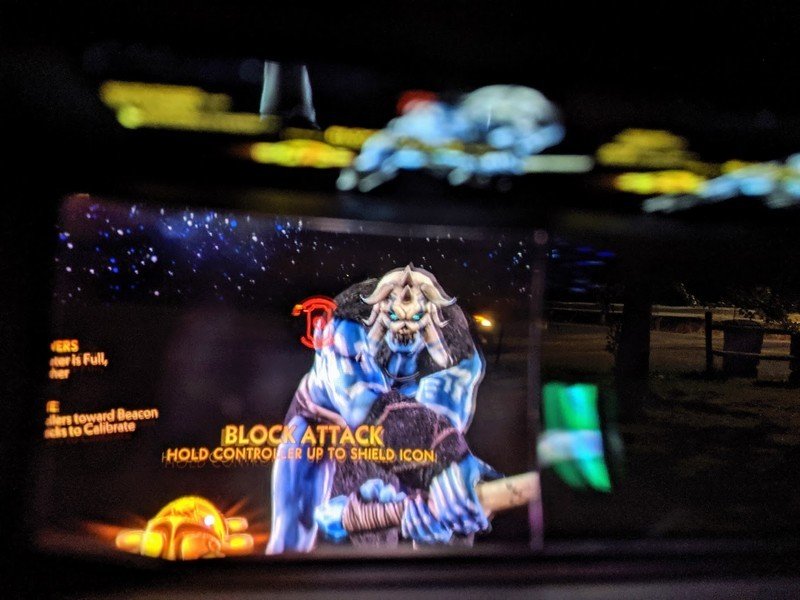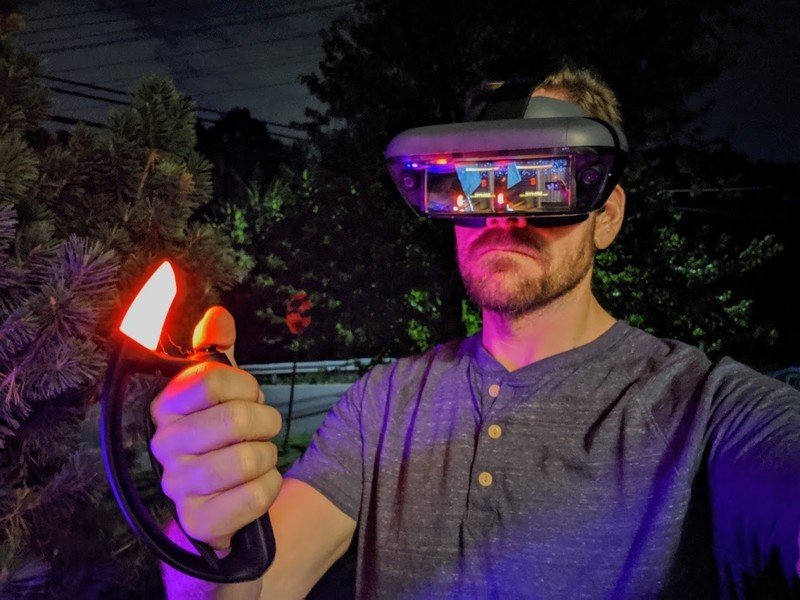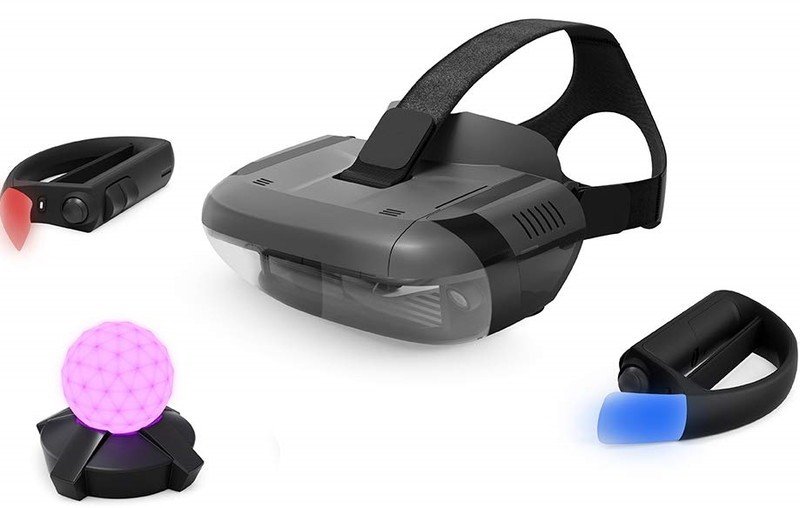Two years ago, Disney partnered with Lenovo to bring one of the most iconic weapons of all time to hundreds of thousands of homes and give those people the ability to fight enemies from all over the Galaxy. Star Wars: Jedi Challenges did an amazing job fulfilling the urge to be a lightsaber-swinging badass for a lot of people, and the software grew to include way more than just that one experience over time. In a time where all of the excitement was surrounding Virtual Reality through your phone, seeing Lenovo push the envelope with an Augmented Reality headset was pretty great. Enough, in fact, to dismiss some of the quirks the headset had that made set up and some aspects of gameplay less than user-friendly.
Today, Disney and Lenovo are back. And instead of a Galaxy Far, Far Away the folks at Disney have dipped into the Marvel pool and made an Augmented Reality experience for everyone who wants to live their best lives as a superhero. Marvel's Dimension of Heroes is a unique and compelling story, separated from the Cinematic Universe entirely while pulling from some of the best parts of the comics, and gives the player the ability to save the world with five of the most popular characters today.
Unfortunately, Lenovo's recent contributions to this experience are somewhat less impressive.
The Good
- Hours of shareable, repeatable gameplay
- Fantastic new controllers
- Iconic characters to play as
- Genuinely fun
The Bad
- The price tag
- Obnoxious setup process
- Lots of tracking and drift issues
- Bulky, heavy headset
Marvel Dimension of Heroes: What I like

How do you design a single set of controllers capable of offering a natural-feeling gameplay experience for Black Panther, Thor, Captain America, Captain Marvel, and Star-Lord? You make it so the controllers almost feel like they're not even in your hands while you're playing. Where Jedi Challenges had you firmly grip a replica-quality lightsaber, there's just too many options here to make just a choice for Dimension of Heroes. So instead, Lenovo offered up a pair of three-button controllers that attach to your palms with elastic bands. These controllers stay firmly in place while you play without needing to grip anything or squeeze anything, allowing you to move and play much more naturally. And with the placement of the four action buttons and two joysticks, you can easily do more than just wave your arms around when you need to.
This is the kind of experience that leaves a huge smile on your face for hours after you've played because there's basically nothing else like it.
This flexibility and comfort is important because each of the five heroes in the game plays very differently. When you're playing as Thor, you need to carefully plan your hammer throws and be ready to summon the Lightning at a moment's notice. Captain Marvel, on the other hand, is a ranged shooter with some impressive up-close combat capabilities. And of course Black Panther has neither energy weapons nor big things to throw, so the focus is much more on close combat and technology. The broad strokes for each of these characters are the same, in that you have a basic attack and a charged attack, followed by some special attacks when you charge up during combat. And each character can block attacks, though obviously blocking as Captain America with his mighty shield is far easier than Star-Lord with his quad blasters. You have to learn how each character plays and make the most of their respective strengths, which despite having Doctor Strange as your guide through this fight, does not include a ton of tips and tricks for survival.
Get the latest news from Android Central, your trusted companion in the world of Android
Speaking of the good Doctor, the story for this game both surrounds him and doesn't really have anything to do with him, which is kind of fun. The Dread Dormammu has come for Earth, and our Mightiest Heroes actually lost! Strange has used his Time powers to bring these five heroes back and help them succeed where they had once failed. This means fighting enemies from all over the Marvel-verse, including Ultrons and Kree and even some heavier hitters like Winter Soldier and Ronan The Accuser. The ultimate goal is for each character to survive their personal journeys and to work together to defeat Dormammu. In the Story Mode, you play through three missions for each character before getting to the final showdown. And once you've had your fill of Story Mode, you can pick your favorite character and smash your way through an endless gauntlet of increasingly impossible odds to see how high you rank on the leaderboard.
The actual gameplay in Dimension of Heroes is fantastic. Each level is great at getting you to move around, dodging and swinging and getting excited about fighting these things on you can see. And if you know someone with another headset, the co-op mode looks like a ton of fun. And that's what has always made the Lenovo AR headset so special. It is really easy to get sucked into this game for an hour and not know how long you've been defending the planet until your arms hurt. This is the kind of experience that leaves a huge smile on your face for hours after you've played because there's basically nothing else like it.
Marvel Dimension of Heroes: What I don't like

Two years ago, the Lenovo AR headset was charming. A little on the heavy side, and had some accuracy issues for sure, but the positives greatly outweighed the negatives for tech that had never really existed in this form before. As a first-generation release, it showed a lot of potential and was also a ton of fun. Unfortunately for everyone who might get excited about this game, it's 2019, and very little about the challenges found in that first released have really been addressed. For starters, this headset is still well over a pound before you add the phone. Plus, all of that weight is out in front with very little support from the straps holding it to your head. It weighs slightly more than an Oculus Quest when there's a phone in the headset, with none of the engineering done to help disperse the weight at all.
It feels like Lenovo decided it wasn't worth updating the core experience at all.
Setting up Lenovo's Mirage AR headset is still a pain. Out of the box, there are so many steps between pulling the controllers out and playing the game. You have to connect the controllers, make sure the light beacon is appropriately far away, confirm everything is working in the app, put the phone in the headset shell, put the headset shell in the headset, and connect the cable from the phone to the headset. Then adjust the headset, so it fits, and the text isn't blurry or off-center. Every time you want to play, you have to do these same steps, there are no shortcuts. It's tedious for someone who knows what they're doing, but a less tech-savvy person is going to get frustrated and take it all back. Especially if there are hardware connection problems like I experienced when the first kit Lenovo sent me refused to pair to three different phones. A new set up fixed that, but it's not hard to see how easily this could all go wrong for someone who isn't particularly familiar with how this tech works.
Once you have everything set up and you're ready to play, there's a calibration set up you have to go through before playing each level. Stare down at the light beacon, hold out your arms with the controllers at a slight angle, and press the joysticks down to calibrate. Not quite as elegant as the calibrate button on the lightsaber, but functionally similar an easy enough for everyone to be able to do. And if this was the one time during a single gameplay session where you'd have to use that re-calibration function that would probably be okay. The same kind of controller drift that would cause lightsabers to not perfectly align in the last iteration of this experience is persistent in this game. The problem now is you have two hands and lots more to do than just swing a glowing sword. Star-Lord's blasters can easily drift out of place and make aiming more difficult. At one point, Black Panther's claws had twisted entirely around on themselves so it was like I was upside-down. This can be fixed with re-calibration but in the middle of a fight that's really awkward.
This system is a lot of fun, but it's also costly. It's $50 more than Jedi Challenges was at launch two years ago, the price of which has now dropped to $70 in many places. And there are so many parts of this that are literally the same as the original system; you can't help but laugh. The list of approved phones stops at the Galaxy S9 in all of the retail and marketing material as if to say testing on new devices stopped shortly after the headset shipped two years ago. No Galaxy S10 mentioned anywhere, though to be clear, it's the phone I used for everything and worked great. But the more I use the headset, the more it feels like Lenovo decided it wasn't worth updating the core experience at all. That is deeply confusing to me because there are so many apparent issues that persist years later.
Marvel Dimension of Heroes: Should you buy it?
Honestly, for most people, my answer right now is no. Marvel Dimension of Heroes is a lot of fun. The gameplay is compelling, and the dialogue got a couple of genuine laughs out of me. But this is a game in search of a better platform than it has, and there's not a ton to be done about that. Lenovo stepped up and offered some great controllers for a fundamentally flawed experience, and it's just not enough. When this system works, it's incredible. But it so rarely "just works" that I can't recommend it to most folk at this price.
3.5 out of 5
This will likely find a niche audience when the price has come down, or perhaps a couple of software updates may address some of the weird problems I have during gameplay. There's a good chance either of those things would make this a more palatable experience. But for now, I'm going to hesitate to show this to even my nerdy friends out of fear it would turn them off to Augmented Reality entirely.



